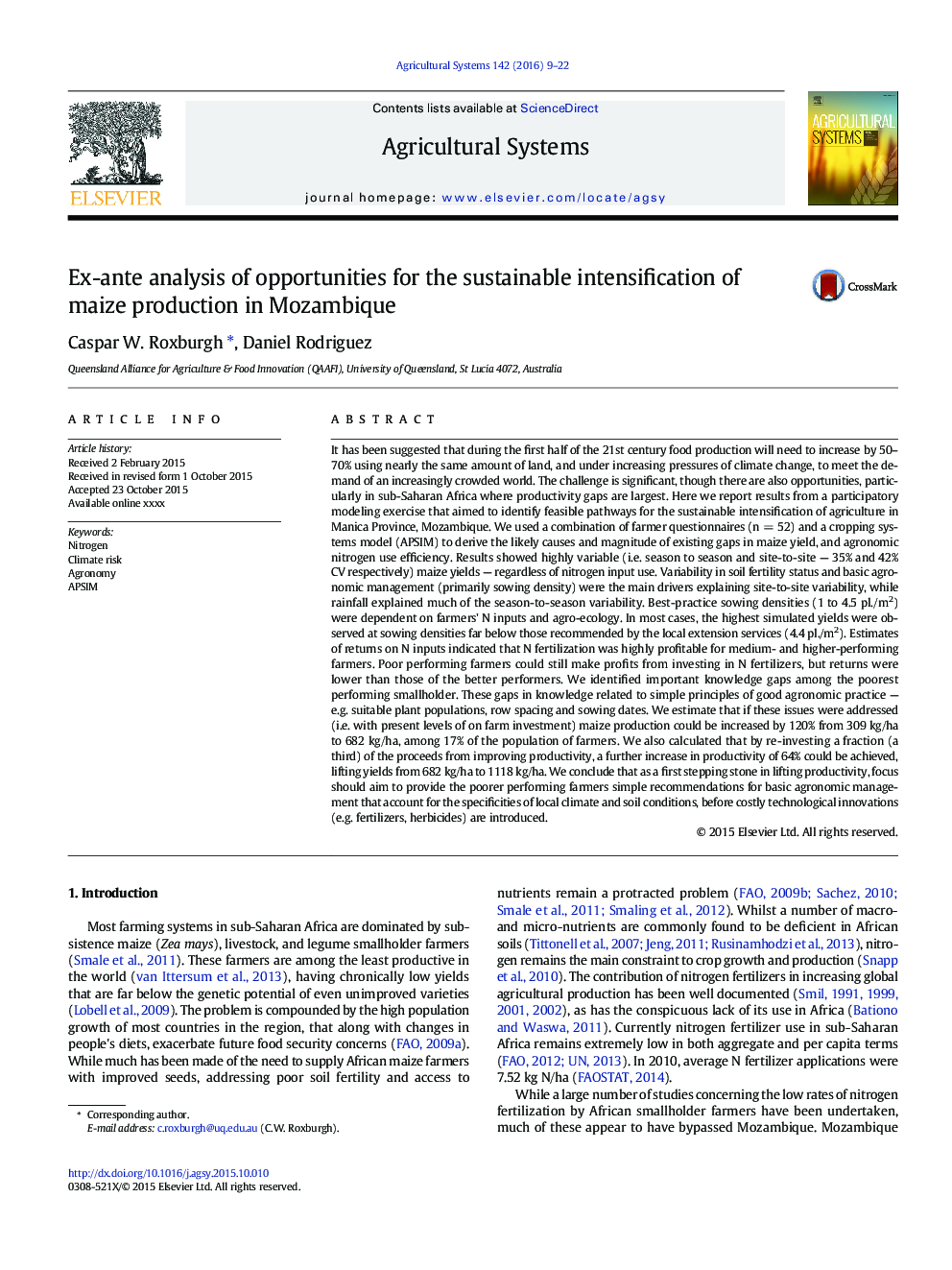| کد مقاله | کد نشریه | سال انتشار | مقاله انگلیسی | نسخه تمام متن |
|---|---|---|---|---|
| 6368357 | 1623228 | 2016 | 14 صفحه PDF | دانلود رایگان |
عنوان انگلیسی مقاله ISI
Ex-ante analysis of opportunities for the sustainable intensification of maize production in Mozambique
دانلود مقاله + سفارش ترجمه
دانلود مقاله ISI انگلیسی
رایگان برای ایرانیان
موضوعات مرتبط
علوم زیستی و بیوفناوری
علوم کشاورزی و بیولوژیک
علوم کشاورزی و بیولوژیک (عمومی)
پیش نمایش صفحه اول مقاله

چکیده انگلیسی
It has been suggested that during the first half of the 21st century food production will need to increase by 50-70% using nearly the same amount of land, and under increasing pressures of climate change, to meet the demand of an increasingly crowded world. The challenge is significant, though there are also opportunities, particularly in sub-Saharan Africa where productivity gaps are largest. Here we report results from a participatory modeling exercise that aimed to identify feasible pathways for the sustainable intensification of agriculture in Manica Province, Mozambique. We used a combination of farmer questionnaires (n = 52) and a cropping systems model (APSIM) to derive the likely causes and magnitude of existing gaps in maize yield, and agronomic nitrogen use efficiency. Results showed highly variable (i.e. season to season and site-to-site - 35% and 42% CV respectively) maize yields - regardless of nitrogen input use. Variability in soil fertility status and basic agronomic management (primarily sowing density) were the main drivers explaining site-to-site variability, while rainfall explained much of the season-to-season variability. Best-practice sowing densities (1 to 4.5 pl./m2) were dependent on farmers' N inputs and agro-ecology. In most cases, the highest simulated yields were observed at sowing densities far below those recommended by the local extension services (4.4 pl./m2). Estimates of returns on N inputs indicated that N fertilization was highly profitable for medium- and higher-performing farmers. Poor performing farmers could still make profits from investing in N fertilizers, but returns were lower than those of the better performers. We identified important knowledge gaps among the poorest performing smallholder. These gaps in knowledge related to simple principles of good agronomic practice - e.g. suitable plant populations, row spacing and sowing dates. We estimate that if these issues were addressed (i.e. with present levels of on farm investment) maize production could be increased by 120% from 309 kg/ha to 682 kg/ha, among 17% of the population of farmers. We also calculated that by re-investing a fraction (a third) of the proceeds from improving productivity, a further increase in productivity of 64% could be achieved, lifting yields from 682 kg/ha to 1118 kg/ha. We conclude that as a first stepping stone in lifting productivity, focus should aim to provide the poorer performing farmers simple recommendations for basic agronomic management that account for the specificities of local climate and soil conditions, before costly technological innovations (e.g. fertilizers, herbicides) are introduced.
ناشر
Database: Elsevier - ScienceDirect (ساینس دایرکت)
Journal: Agricultural Systems - Volume 142, February 2016, Pages 9-22
Journal: Agricultural Systems - Volume 142, February 2016, Pages 9-22
نویسندگان
Caspar W. Roxburgh, Daniel Rodriguez,